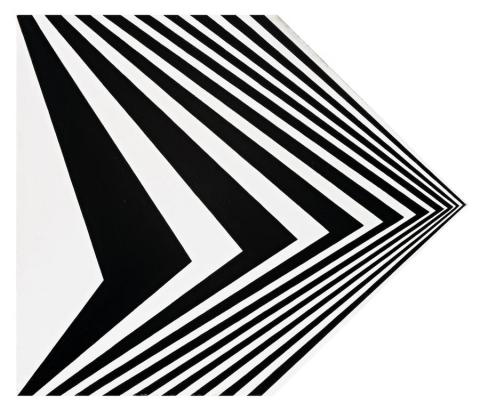OFF, 1963
BRIDGET RILEY
emulsion on hardboard (housed in Perspex)
24.5 x 29.0 cm (irregular)
signed and dated on edge: RILEY '63
Collection of Lex Aitken and Alfredo (Bouret) Gonzalez, Sydney, acquired directly from the artist
Bridget Riley, Gallery One, London, 9–28 September 1963
Bridget Riley: Works 1960–1966, Hazlitt Holland-Hibbert and Karsten Schubert, London, 2012, p. 89 (illus.)
Insistently abstract with its stark monochrome palette and arresting formal arrangement, Off, 1963 is a compelling example of the controversial Op Art compositions which first brought Riley international recognition during the 1960s. Seemingly bereft of any trace of the external world, such works featured geometric shapes - squares, ovals, circles and triangles - structured in increasingly subtle and disorienting ways. Not surprisingly perhaps, critics at the time frequently interpreted these works as purely formal exercises or worse, dismissed them as decorative 'trompe l'oeil' pursuits. Yet while utilising precise structures, Riley does not intend these as ends in themselves; instead the viewer is drawn into a dialogue with the work, thus subverting the prevailing conventional assumption that a painting is an essentially passive, inert object.1 As Riley herself muses, the appearance of a painting such as Off is 'as much inside one as it is 'out there'.'2 Accordingly, it would seem futile to attempt to describe Off for example, in terms of arrows or chevrons for, while the work's nature is in a sense 'contained' in these ostensible surface marks, its meaning only emerges through the viewer's very private and unique responses to the sensations elicited by the painting's physical features. Thus evoking a range of visual experiences - some viewers might focus upon the implication of movement, while others the sense of compression, and still more might perceive light as colour - the composition remains deliberately enigmatic. As the artist asserts, 'I want my paintings to exist on their own terms. That is to say they must stealthily engage and disarm you. There the paintings hang, deceptively simple - telling no tales as it were - resisting, in a well behaved way, all attempts to be questioned, probed or stared at and then, for those with open eyes, serenely disclosing some intimations of the splendours to which pure sight alone has the key.'3
1. Moorhouse, P., 'The ultimate secret of things: Perception and sensation in Bridget Riley's art' in Bridget Riley: Paintings and Drawings 1961-2004, Ridinghouse, London, 2004, p. 15
2. Riley, cited ibid.
3. Riley, cited in Moorhouse, P., (ed.), Bridget Riley, room brochure accompanying exhibition, 'Bridget Riley', Tate Britain, London, 26 June - 28 September 2003
VERONICA ANGELATOS
